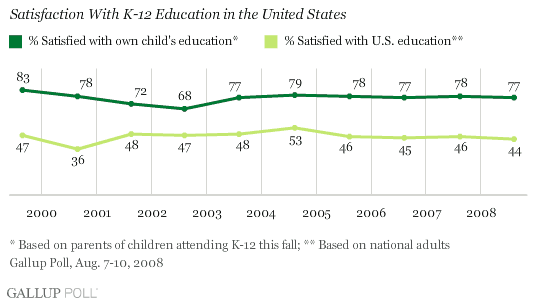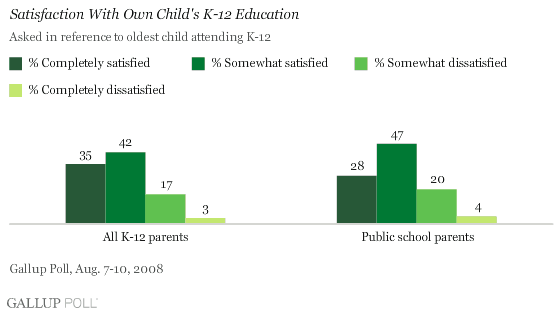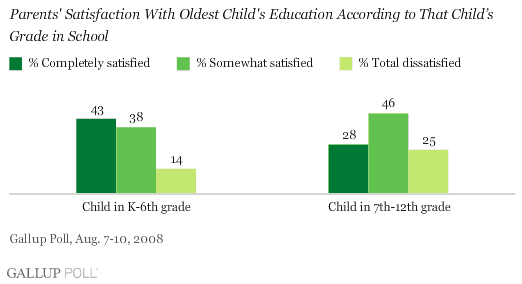PRINCETON, NJ -- As the nation's schoolchildren dig out and dust off their backpacks, only 44% of U.S. adults are satisfied with the quality of primary and secondary education in the country, contrasted with 77% of parents of school-aged youth saying they are satisfied with their own children's education. Ā鶹“«Ć½AV has recorded a similar perception gap for the past decade.

The corollary findings, from Ā鶹“«Ć½AV's Aug. 7-10 Work and Education survey, are that 53% of Americans are dissatisfied with the quality of education in the country and 20% of parents are dissatisfied with their oldest child's schooling. (Parents with more than one child were asked to rate the education their oldest child is receiving.)
Since 1999, public satisfaction with the quality of education in kindergarten through grade 12 has generally fallen near the average 46% level seen across this period. One exception is August 2000, when only 36% of Americans were satisfied. Diminished satisfaction with the quality of education in that survey could have reflected public reaction to George W. Bush's focus on problems in education and the need for standards-based reform in his 2000 presidential campaign -- a focus that ultimately led to the passage of the No Child Left Behind Act of 2001.
Barely a Third of Parents "Completely Satisfied"
While parents are generally satisfied with their own children's schooling, there is ample room for improvement in those attitudes. Overall, just 35% of all K-12 parents say they are "completely satisfied." The figure is even lower (28%) among the subset of parents whose children attend public schools.

The greatest work in addressing parents' concerns needs to be done at the upper grade levels. Only 28% of parents of children attending grades 7 through 12 are "completely satisfied" with their children's education, compared with 43% of parents of kindergartners through sixth graders.

Bottom Line
Parents of school-aged children are feeling pretty good about the education their oldest child will receive this fall. That's the good news out of Ā鶹“«Ć½AV's annual update on attitudes toward education in the United States. The troublesome news is that, despite several years of No Child Left Behind changes operating in the nation's schools, Americans are no more confident about the quality of education being delivered than they were in 1999, before Bush formally proposed the reforms.
Survey Methods
Results are based on telephone interviews with 1,009 national adults, aged 18 and older, conducted Aug. 7-10, 2008. For results based on the total sample of national adults, one can say with 95% confidence that the maximum margin of sampling error is Ā±3 percentage points.
For results based on the sample of 253 parents with children in kindergarten through grade 12, the maximum margin of sampling error is Ā±7 percentage points.
Interviews are conducted with respondents on land-line telephones (for respondents with a land-line telephone) and cellular phones (for respondents who are cell-phone only).
In addition to sampling error, question wording and practical difficulties in conducting surveys can introduce error or bias into the findings of public opinion polls.
To provide feedback or suggestions about how to improve Ā鶹“«Ć½AV.com, please e-mail feedback@gallup.com.
